Date: September 21
Speaker: John G. Harris, Chair, Department of Electrical and Computer Engineering, University of Florida
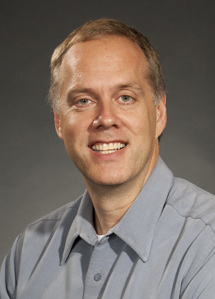
Title: “Biologically Inspired Computation Using DSP and Analog Circuit Implementations”
Abstract: There is growing interest in using biological-inspiration to improve the design of computation systems, particularly in the areas of sensory processing and pattern recognition where biological systems far outperform the best man-made devices. For instance, state-of-the- art speech and face recognition algorithms pale in comparison to human performance despite hundreds of man-years of research in these fields. We survey several examples of our work in biologically-inspired engineering designs, including research with Motorola on improving cell-phone speech quality, a new type of digital camera with much wider dynamic range, an implant for wirelessly recording neural signals for brain-machine interfaces and a general computer architecture for spike-based computation. In each case, the study of biology leads to natural and effective engineering solutions that can be implemented in DSPs or in special-purpose analog VLSI circuits.
Biography: Dr. John G. Harris earned his BS and MS degrees in Electrical Engineering from MIT in 1983 and 1986, and earned his Ph.D. from Caltech in 1991. Harris joined the Electrical and Computer Engineering Department at Florida in 1993. For his research, Harris develops biologically inspired circuits, architectures and algorithms for signal processing. Harris has published over 100 research papers and patents in these research areas. In August of 2011, Dr. Harris became the chair of the ECE department at the University of Florida.
Date: October 5
Speaker: Frank Chang, Wintek Chair Professor and Chairman, UCLA Electrical Engineering
Title:“Next Generation Communication/Radar/Imaging Systems-on-Chip”
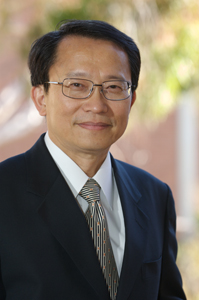
Abstract: There is an increased interest in recent times to explore mm-Wave and Sub-mm-Wave (Terahertz) systems from 60-1000GHz (i.e. 1 Terahertz) for radio, radar, and imagers due to unique quasi-optical characteristics of such wave spectra. Continuous scaling has made modern CMOS with gate dimensions less than 65-40nm a potential contender with improved device speed (cut-off frequencies ft and fmax >300GHz) and superior System-on-a-Chip integration. Nevertheless, deep-scaled CMOS suffers its own disadvantages from limited linearity/dynamic range, low intrinsic gain, high process variation and excessive substrate loss. In this seminar, we will discuss various algorithms and techniques developed at UCLA to overcome CMOS technology drawback in order for implementing highly integrated and portable radio/radar/imager systems with unprecedented spectra coverage, energy efficiency and cost/size-effectiveness.
Biography: Frank Chang is the Wintek Chair Professor and Chairman of UCLA Electrical Engineering. Before joining UCLA in 1997, he was the Assistant Director and Department Manager of High Speed Electronics Laboratory at the Rockwell Science Center in Thousand Oaks, California (1983-1997). He was elected to the US National Academy of Engineering in 2008 and to Academia Sinica of Taiwan, Republic of China in 2012 for his research in advancing modern High Speed Electronics. He is an IEEE Fellow and received the IEEE David Sarnoff Award in 2006.
Date: November 30
Speaker: T.E. Schlesinger, David Edward Schramm Professor and Chair, Electrical and Computer Engineering, Carnegie Mellon University
Talk 1 Title:“Exploring New Paradigms in Technology”
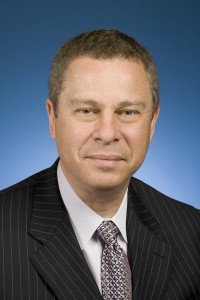
Abstract: As the scaling of semiconductor device technology, commonly described by “Moore’s Law”, comes to an end, many people may be led to believe that the ability to continue to advance technology dramatically has come to an end in general. This however, is far from the case. Rather, what we are seeing is that a particular engineering paradigm is coming to an end, not technology development in general. In this presentation I will offer some “back of the envelope” arguments as to why technology has not reached any sort of limit and why orders of magnitude advances in technology are still quite possible. I will then describe two projects my colleagues and I are working on at Carnegie Mellon; one in data storage systems and the other in circuit technology. Both projects seek to exploit new technology paradigms. Finally I will discuss my reasons for great optimism in the potential of new technology paradigms and the implications of these developments.
Talk 2 Title: Electrical and Computer Engineering Curricula without Boundaries
Abstract: Departments of Electrical and Computer Engineering (ECE) (and departments with similar names) emerged during the past thirty years in response to the growth of computer engineering as a distinct discipline. Most ECE departments still offer two separate bachelors degrees in electrical engineering and computer engineering, and ABET has two distinct accreditation requirements for programs in electrical engineering and programs with “computer engineering” in their titles. We believe that this distinction between “electrical engineering” and “computer engineering” is no longer useful or helpful in undergraduate ECE education. We believe all ECE students need a solid, unified foundation that cuts across the traditional boundaries and that advanced courses should be associated with more refined distinctions than the binary classification of EE vs. CE. I will present our ECE curriculum at CMU an how it eliminates the outdated EE/CE distinction and describe how this better prepares ECE students to pursue advanced courses and careers in a wide range of disciplines and careers.
Biography: T.E. Schlesinger is the David Edward Schramm Professor and Head of Electrical and Computer Engineering at Carnegie Mellon University. Prior to this, he was the Director of the Data Storage Systems Center, Associate Department Head in ECE, and was the founding co-director of the General Motors Collaborative Research Laboratory at CMU. He received his B.Sc. degree in Physics from the University of Toronto in 1980 and his M.S. and Ph.D. degrees in Applied Physics from the California Institute of Technology in 1982 and 1985 respectively. He is a Fellow of the IEEE and the SPIE, is President of the ECE Department Heads’ Association, and was a member of the International Advisory Panel for the A*STAR Graduate Academy. and is on the Advisory Board for the ECE Department, Georgia Tech.
Date: March 8
Speaker: Babak Hassibi, Executive Officer of Electrical Engineering, Professor of Electrical Engineering, California Institute of Technology
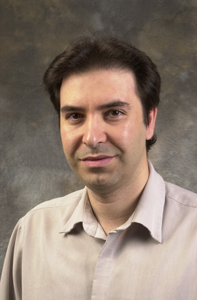
Title: “Phase Recovery for Sparse Signals”
Abstract: The problem of reconstructing a signal from measurements of the “amplitude” of its Fourier transform is a classic problem referred to as phase recovery (because the phase of the Fourier transform must be recovered in order to reconstruct the signal) and occurs in numerous applications in science and engineering. Since amplitude information is not sufficient to recover the signal, some form of prior information must be assumed. In this talk, we will assume that the underlying signal is sparse (i.e., has only a few non-zero entries); this is a very reasonable assumption in applications in astronomy, x-ray crystallography, wireless communications, etc., and is a theme that has recently garnered a great deal of attention in the context of compressed sensing.
We first prove that, provided the support of the unknown signal is not “periodic”, it can be uniquely (up to time shifts and reflections) reconstructed from the magnitude of its Fourier transform. We then focus on practical algorithms to perform this recovery. We show that standard “lifting” methods that relax the problem to a semi-definite program (SDP) do not work. Instead, we employ a two-phase strategy: we first recover the support of the unknown signal using a combinatorial algorithm (of quadratic complexity), and then use the support information to recover the signal using an SDP. We prove that the algorithm is successful, provided the sparsity is less \sqrt{n}, where n is the length of the unknown signal. This is the first such guarantee for phase recovery of sparse signals. We mention some generalizations, open problems, and connections to compressed sensing, low-rank matrix recovery and the turnpike problem.
Biography: Babak Hassibi is professor and executive officer of electrical engineering at the California Institute of Technology, where he has been since 2001. From 1998 to 2001 he was a member of the technical staff at the Mathematical Sciences Research Center at Bell Laboratories, Murray Hill, NJ, and prior to that he obtained his PhD in electrical engineering from Stanford University. His research interests span different aspects of communications, signal processing and control. Among other awards, he is a recipient of the David and Lucille Packard Foundation Fellowship, and the Presidential Early Career Award for Scientists
Date: April 5
Speaker: Robert Lee, Chair, Electrical and Computer Engineering Department, The Ohio State University
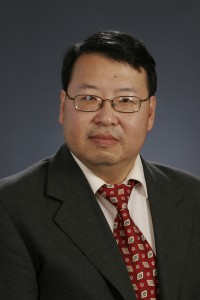
Title:“Development of New Finite Difference Time Domain Methods for Electromagnetics Based in Finite Element Concepts”
Abstract: Because of accuracy problems, researchers have worked to develop improvements to the traditional finite difference time domain (FDTD) method over the past 40 years. Although there has been some success, improvement has been slow. In my opinion, the slow progress is due to the FDTD formulation itself. The approach that we have taken is to formulate the FDTD method in terms of finite element concepts. The resulting framework allows us to use the vast capabilities developed for the finite element method to improve the FDTD method. The resulting formulation can then be translated back into the FDTD stencils and coupled directly to the rest of the grid where standard FDTD is used. This approach has allowed us to develop robust algorithms for subgridding, higher order stencils, anisotropic media modeling, and multiple time steps methods. In this presentation, we will present results demonstrating our success using this approach.
Biography: Robert Lee received his BSEE in 1983 from Lehigh University and his MSEE and Ph.D. in 1988 and 1990, respectively, from the University of Arizona in Tucson. From 1983 to 1984, he worked for Microwave Semiconductor Corporation in Somerset, NJ as a Microwave Engineer. Since 1990, he has been at The Ohio State University where he currently is Professor and Department Chair of Electrical and Computer Engineering. Lee teaches courses in the area of electromagnetics, is an IEEE Fellow, and is on the ISI highly cited list.
Date: April 12
Speaker: Ahmed Tewfik, Cockrell Family Regents Chair in Engineering and Chairman, Electrical and Computer Engineering, Univeristy of Texas
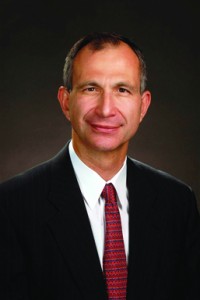
Title: “Behavioral Networking and Decision Making”
Abstract: This talk will begin with an overview of cognitive biases. It will then describe our work on mathematical models of human decision making at the individual and group levels. In particular, we seek to study differences between human decision making and optimal decision making in a Bayesian or Neyman-Pearson framework. Cognitive biases imply that human decision making is not equivalent to an optimal Bayesian test. We hypothesize that human decision making can be modeled by a sufficient static that captures all the intrinsic information, a threshold and an additive term that depends on extrinsic and intrinsic information and past decisions. Finally, the talk considers how information should be sequenced to help groups make optimal decisions. Sequencing in this context refers to the time order in which the information is presented to each individual and when communications between individuals is encouraged or discouraged. Our recent work in a detection context (using divergence of measure analysis) shows that the average decision time in problems with a desired probability of detection can be reduced by appropriate sequencing.
Biography: Ahmed H Tewfik received his B.Sc. degree from Cairo University, Cairo Egypt, in 1982 and his M.Sc., E.E. and Sc.D. degrees from MIT, in 1984, 1985 and 1987 respectively. He is the Cockrell Family Regents Chair in Engineering and the Chairman of the Department of Electrical and Computer Engineering at the University of Texas. He was the E. F. Johnson professor of Electronic Communications with the department of Electrical Engineering at the University of Minnesota until September 2010. Dr. Tewfik worked at Alphatech, Inc. and served as a consultant to several companies. From August 1997 to August 2001, he was the President and CEO of Cognicity, Inc., an entertainment marketing software tools publisher that he co-founded, on partial leave of absence from the University of Minnesota. Tewfik is a Fellow of the IEEE. He was a Distinguished Lecturer of the IEEE Signal Processing Society in 1997 – 1999. He received the IEEE third Millennium award in 2000.